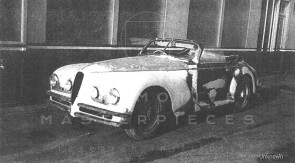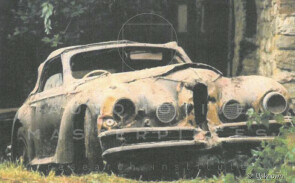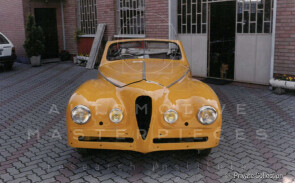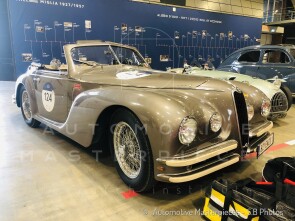
1943 Alfa Romeo 6C 2500 SS
ON/OFF
Why am I an Automotive Masterpiece?
L. Limited edition cars
no. 6 manufactured, 5th built
The history of Alfa Romeo coincides basically with that of the history of the automobile and features many stories and numerous cars. The Alfa Romeo 6C stands out amongst the most representative models – the cars of the beginning and the modern post-war ones, and the racing and touring cars. The long journey of the Alfa Romeo 6C lasted almost 25 years, accompanying Alfa Romeo industries from the 20s to the 50s. In the early 1920s, Vittorio Jano was commissioned with creating a lightweight, high-performance vehicle to replace the large and heavy RL and RM models. The Alfa Romeo 6C was not only a model, but a complete range of road, race, and sports cars, produced between 1927 and 1954. The "6C" name refers to the number of cylinders of the car's inline-six engine. The different models’ bodies were made by coachbuilders such as Castagna, James Young, Pinin Farina, Touring and Zagato. From 1933, an Alfa Romeo built body also became available; it was made in Portello. The car was introduced in April 1925 at the Salone dell'Automobile di Milano as the 6C 1500, since the 2-litre class - that led Alfa Romeo to win the Automobile World Championship in 1925 - changed into the 1.5-litre class for 1926’s race season. The production started in 1927, with the P2 Grand Prix car as a base model. The more powerful 6C 1750 was introduced in 1929 in Rome. It was produced in six series between 1929 and 1933. Most of the cars were sold as a bare-chassis, then bodied by coachbuilders. The 1750 quickly gained a reputation for winning races. In 1933, the new Alfa Romeo 6C 1900 version was introduced, with a displacement of 1917 cc and with a light alloy head – used here for the first time. The powerful 8C 2300s, despite their successes, remained reserved for races and, to satisfy the market’s request for a high-performance automobile sold at a lower price, Alfa Romeo introduced the 6C 2300 at the Salone dell’Auto di Milano in 1934, designed to replace the 6C 1900. That same year, three 6C 2300 Gran Turismo bodied by Carrozzeria Touring won the first three places at the 24 Ore di Pescara. Therefore, after the race, Alfa Romeo began to sell the model under the new “Pescara” name. The arrival of the 6C 2300 B was a real revolution, introducing a chassis with independent suspensions on the four wheels. This car was the undisputed leader in the history of the Mille Miglia race from 1935 to 1938, with various 6C models competing as part of fully-fledged teams, driven by some of the most talented drivers of the era.
The Alfa Romeo 6C 2300 was succeeded by the 6C 2500, the final model in the series before World War II. When production resumed after the war, numerous special versions were created, showcased at concours d’elegance, and still made significant impacts in races. While the 6C 2300 B of 1935 marked a departure from the original 6C design, the engine maintained a direct connection to its roots. The evolution of the 6C engine, which began in 1925, culminated in the final 2.5-liter displacement. This design, conceived by Vittorio Jano, remained fundamentally unchanged and continued in production until 1953. The Sport version of the 6C 2500 debuted at the 1939 Berlin Motor Show, followed by the Turismo soon after. In 1942, the chassis underwent a significant redesign, featuring a stiffened central crossbeam that replaced the earlier parallel beams. The 6C 2500 Sport version featured an engine derived from the 6C 2300 B Mille Miglia. The displacement increase was achieved by enlarging the bore by 2 mm. It utilized a Weber 36 DCR carburetor similar to that of the Turismo model but with modified specifications. The Sport model was equipped with 5.50x18 tires on wire wheels. No Sport models were produced in 1941 due to wartime priorities. In 1942, the Sport model adopted the same chassis modifications as the Turismo model, starting with frame no. 915119. Wartime production constraints led to only a few cars being built in 1943 and 1944. After the war, production resumed, and many chassis were supplied to independent coachbuilders for bespoke designs. Pinin Farina and Touring received most of these commissions, followed by Stabilimenti Farina, Ghia, Boneschi, Castagna and many others. A noteworthy development was the creation of the famous Super Sport version, derived from the 6C 2500 Sport. This model, designed for competition, featured a shortened chassis and three carburetors instead of one. The Super Sport lineage began in 1939 with the 256 model—a racing version with Scuderia Ferrari origins, as indicated by its name (2.5 liters, 6 cylinders). It evolved into the Super Sport road car, which remained in production until 1953, with Carrozzeria Touring's iconic "Villa d'Este" coupe serving as its pinnacle. The last 6C 2500 Sport example was built in 1950. The 2500 marked the end of the 6C series and was succeeded by the Alfa Romeo 1900.
The Alfa Romeo 6C 2500 SS (Carrozzeria Turinga), chassis no. 915527, is the fifth of only six “SS” built in 1943. It was completed as a chassis on August 31, 1943, and delivered to Carrozzeria Touring on June 9, 1945. The bodywork is identified by number 2663, which significantly predates the issuance of the certificate of origin. Although officially completed in 1945, the bodywork number dates back to the wartime period, suggesting that it might have been partially built around 1943 but not finished at the time. Supporting this hypothesis is the presence of side panels with shaped fenders, a feature not used on SS models after 1943–44. Meanwhile, the front end displays characteristics typical of SS models produced by Touring in 1945–46, such as the wider grille with rectangular mesh, dual headlights, and dual blade bumpers. These details indicate that the front fascia might have been updated before the car's sale to align it with current production or that the bodywork construction began during the war and was only completed in 1945. The badges on the bodywork bear the name “Turinga” rather than “Touring.” This temporary rebranding reflected the fascist regime's policy against Anglicisms. Despite some sources suggesting otherwise, the "Turinga" name did not come into use before 1943 and remained in use for several months after the war, only reverting to "Touring" definitively by late 1946. Some unverified sources claim that chassis no. 915527 was first owned by Baron Napoléon Gourgaud du Taillis in France. However, even if he was the person who ordered the car at the time no documents or testimonies support this claim. The discovery of an original 1945 Italian license plate for the chassis enabled the reconstruction of its history before its arrival in Switzerland in 1947. The chronological record, obtained through the Archivio Targhe project, which aims to create a comprehensive archive of Italian license plate records, reveals that the first owner was Joan R. Macroy, most likely an American soldier. He soon sold the car to Michelangelo Leonardi di Casalino for 400,000 lire. On September 20, 1945, the car was registered in his name as Roma 88518. Leonardi, a gentleman driver and passionate collector of rare cars along with his father Massimiliano, had previously owned several notable Alfa Romeos, including the unique Alfa Romeo 8C 2900B Le Mans Berlinetta. He competed in the Mille Miglia twice, driving a Lancia Aurelia B20 in 1952 and a Ferrari 166 MM in 1953, along with many other races between the 1930s and 1950s. However, he kept chassis 915527 for only a few months. As a road car in a period when racing had not yet resumed, any sporting past for this car under Leonardi's ownership can be excluded. By early 1946, the car had passed to Silvano Spinelli, also in Rome. In December 1946, the last known Italian owner, Luigina Cairo, acquired chassis no. 915527 just a few months after selling another 6C 2500 SS (chassis no. 915007). Luigina was the wife of Mille Miglia veteran Carlo Masera, who competed in 1930, 1933, and 1935. In April 1947, the car was imported into Switzerland. The first Swiss owner was André Held, a renowned photographer and publisher from Lausanne. Subsequent notable owners included architect André Gaillard and Raymond Hyvert, known in automotive circles for having built a barchetta on Alfa Romeo 1900 mechanicals. Over approximately 17 years, chassis no. 915527 passed through eleven different Swiss owners. In 1960s, it was acquired by French wine connoisseur Michel Dovaz. In 1983, German photographer Herbert Hesselmann had the opportunity to photograph his car collection. The resulting images gained global attention, as the car enthusiast community was stunned by what they saw: a collection of rare and valuable cars in severe states of disrepair. Despite efforts to keep the location undisclosed, hints from Hesselmann's surroundings and details in Walther Wuttke’s article for Der Stern revealed Dovaz’s estate. This exposure attracted thieves and souvenirs collectors, forcing Dovaz to relocate his collection to a château in southern France. In 1986, Hesselmann and Schrader released the book Sleeping Beauties, which documented the collection. In 1989, Dovaz exhibited the vehicles (chassis no. 915527 included) at the French Musée Automobile de Sarlat, but eventually sold most of them, keeping only 14 cars. In 1990, the Turinga was sold in the Netherlands before returning to Italy in 1992. It then entered the hands of car historian Vittorio Serventi, who embarked on a challenging and thorough restoration. For the project, Serventi consulted Carlo Felice Bianchi Anderloni personally. Although Anderloni was unable to locate specific materials related to this car, he vividly recalled the Alfa Romeo 6C 2500 SS as the first model he worked on directly after joining the coachbuilder. This took place following the Armistice of September 8, 1943, when cars were assembled under semi-clandestine conditions. Anderloni noted that chassis no. 915527 retained “old style” fenders but already featured a “new style” front fascia, forming an early version of the Alfa Romeo “trilobo.” However, his recollections regarding the production dates of this model, after many years, should be approached with caution. Anderloni anticipates the dates established by available documentation and raise questions about the origins of the "double headlight" design traditionally associated with Count Trossi's car. The Touring heir confirmed that only a handful of such models were produced and recalled that the car was likely finished in hazelnut brown. The restoration was eventually completed by specialist Celli, and after nearly four years, the car was fully restored, re-registered in Italy, and ready for concours d’elegance and other historic car events. Serventi sold the car in 2002, after which it passed through the hands of other collectors, who also entered chassis no. 915527 in the Mille Miglia re-enactments and Villa d'Este concours d’elegance. Since 2021, the car has been part of a private collection.
![PHOTO-2025-07-04-13-46-01[49]](https://automotivemasterpieces.com/image/d3a60d8e1b92582119a961401c27e74c8a14947d)



